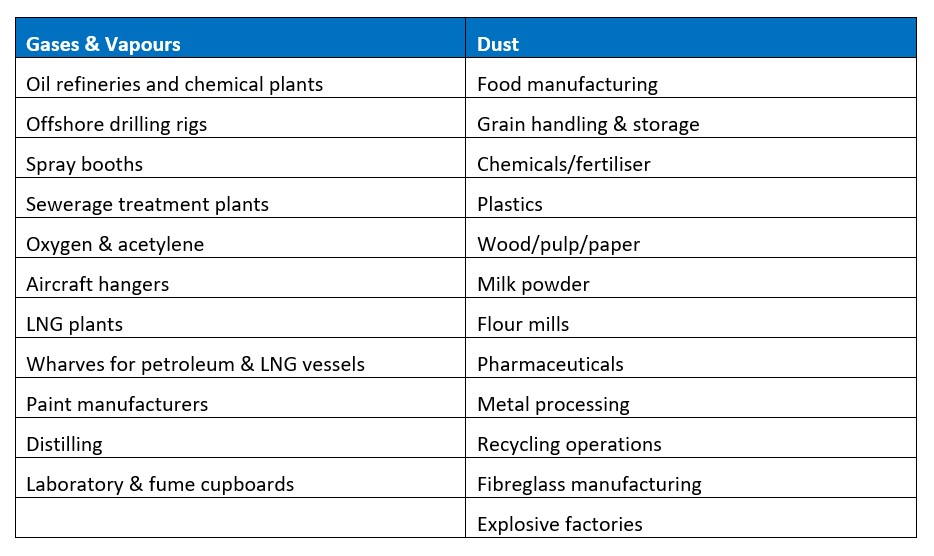The Roar Solutions Ideas
The Roar Solutions Ideas
Blog Article
Some Known Incorrect Statements About Roar Solutions
Table of ContentsThe Definitive Guide for Roar Solutions7 Easy Facts About Roar Solutions ExplainedLittle Known Facts About Roar Solutions.
In order to shield installations from a potential explosion an approach of evaluating and categorizing a potentially unsafe location is required. The objective of this is to make sure the proper choice and installation of devices to ultimately protect against a surge and to make certain safety and security of life.
(https://www.reddit.com/user/roarsolutions1/)
No equipment must be mounted where the surface temperature level of the equipment is more than the ignition temperature of the provided threat. Below are some common dust dangerous and their minimal ignition temperature level. Coal Dirt 380C 225C Polythene 420C (melts) Methyl Cellulose 420C 320C Starch 460C 435C Flour 490C 340C Sugar 490C 460C Grain Dust 510C 300C Phenolic Resin 530C > 450C Aluminium 590C > 450C PVC 700C > 450C Soot 810C 570C The probability of the hazard existing in a concentration high sufficient to trigger an ignition will differ from place to area.
In order to classify this risk a setup is split into areas of risk relying on the quantity of time the unsafe exists. These locations are described as Zones. For gases and vapours and dusts and fibres there are 3 zones. Area 0 Area 20 A dangerous atmosphere is very most likely to be present and may be present for lengthy periods of time (> 1000 hours per year) or perhaps constantly Zone 1 Zone 21 A dangerous ambience is possible but not likely to be present for long periods of time (> 10 450 C [842 F] A classification of T6 implies the minimal ignition temperature is > 85 C [185 F] Hazardous location electrical tools perhaps developed for use in higher ambient temperatures. This would certainly suggested on the ranking plate e.g. EExe II C T3 Ta + 60C( This indicates at 60C ambient T3 will not be exceeded) T1 T1, T2, T3, T4, T5, T6 T2 T2, T3, T4, T5, T6 T3 T3, T4, T5, T6 T4 T4, T5, T6 T5 T5, T6 T6 T6 A T Course score of T1 implies the maximum surface area temperature generated by the instrument at 40 C is 450 C. Assuming the associated T Class and Temperature score for the tools are suitable for the area, you can constantly utilize a tool with a much more stringent Department score than required for the area. There isn't a clear solution to this question. It truly does depend on the kind of devices and what repairs require to be carried out. Tools with particular examination procedures that can not be performed in the area in order to achieve/maintain 3rd party score. Should come back to the manufacturing facility if it is before the devices's solution. Area Repair By Authorised Employee: Challenging screening may not be required nevertheless details procedures may need to be followed in order for the tools to preserve its 3rd event score. Authorised workers have useful reference to be employed to execute the job appropriately Repair have to be a like for like replacement. New element have to be thought about as a direct replacement calling for no unique screening of the tools after the repair work is complete. Each tool with an unsafe rating need to be examined individually. These are detailed at a high degree listed below, but for even more in-depth details, please refer straight to the standards.
The smart Trick of Roar Solutions That Nobody is Discussing
The tools register is a thorough database of devices documents that includes a minimum set of areas to determine each product's location, technical criteria, Ex category, age, and ecological information. The proportion of Thorough to Shut examinations will be determined by the Tools Danger, which is evaluated based on ignition danger (the possibility of a source of ignition versus the likelihood of a flammable atmosphere )and the hazardous location classification
( Zone 0, 1, or 2). Implementing a durable Risk-Based Assessment( RBI )strategy is essential for making sure compliance and security in taking care of Electrical Tools in Hazardous Locations( EEHA).
The Single Strategy To Use For Roar Solutions

In terms of eruptive risk, a harmful location is a setting in which an eruptive environment exists (or might be anticipated to be present) in amounts that need unique precautions for the construction, setup and use devices. Roar Training Solutions. In this article we discover the challenges encountered in the workplace, the danger control actions, and the required proficiencies to function safely
It is a repercussion of contemporary life that we manufacture, store or handle a variety of gases or liquids that are regarded flammable, and a range of dirts that are deemed combustible. These substances can, in specific conditions, create eruptive ambiences and these can have major and unfortunate consequences. The majority of us know with the fire triangle eliminate any type of one of the three elements and the fire can not happen, but what does this mean in the context of dangerous areas? When breaking this down right into its simplest terms it is essentially: a mix of a certain quantity of release or leakage of a certain compound or material, combining with ambient oxygen, and the presence of a resource of ignition.
In the majority of circumstances, we can do little concerning the degrees of oxygen in the air, however we can have significant influence on resources of ignition, for example electrical tools. Harmful areas are documented on the harmful location category drawing and are identified on-site by the triangular "EX" indication. Right here, amongst various other key information, zones are split into 3 types depending upon the threat, the chance and duration that an eruptive environment will certainly exist; Zone 0 or 20 is regarded one of the most dangerous and Area 2 or 22 is considered the least.
Report this page